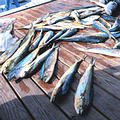 依2006年國家漁跡(Fishprint of Nations 2006)利用「生態足跡」的研究方法發現,為了維持人類現有對水產的消費,將需要現有2.5倍大的海洋才能維持其需求。生態足跡的內容,主要在計算出為供給人類需求,需耗費多少資源。和生態足跡相同,以人口或國家為單位,漁業足跡表示足以供給某國或某人口數漁獲消費量的海洋面積。
依2006年國家漁跡(Fishprint of Nations 2006)利用「生態足跡」的研究方法發現,為了維持人類現有對水產的消費,將需要現有2.5倍大的海洋才能維持其需求。生態足跡的內容,主要在計算出為供給人類需求,需耗費多少資源。和生態足跡相同,以人口或國家為單位,漁業足跡表示足以供給某國或某人口數漁獲消費量的海洋面積。
這份報告由「重新定義發展」(Redefining Progress)、「海洋計劃」(Ocean Project)和永續經濟中心三個獨立機構於15日共同發表,報告估計人類目前過量撈捕已達157%;其中包含美國在內共91個國家,在2003年便已超量捕漁。
海洋計劃主席莫特(Bill Mott)表示:「科學證據低估了海洋對人類存續的影響力,以及人為活動對海洋生態與日俱增的殺傷力。目前趨勢走向看起來相當悲觀,但我們仍有機會挽救,留給後代子孫更豐富健全的海洋環境;畢竟地球上所有人無論住在哪個區域都和海洋緊密連結。」
報告中建議,為維護漁業生產力和海洋生態系的永續發展,劃分一定比例的海洋區域為禁止一切撈捕、開採和干擾活動的「禁漁區」,有其必要性。國家漁業足跡建議,各國至少應劃出20%經濟海域為海洋保護區。
這份報告呼應本月稍早發表在《科學》期刊另一篇論文,該文指出,倘若現行撈捕方式持續而不改善,到2048年之前,所有主要商業漁種都會崩毀消失。
對有心的消費者來說,在海鮮上標示漁業足跡可協助他們購買生態影響較小的食品;因為靠近食物鏈末端的海鮮,對海洋生態影響較小。
扇貝、螃蟹、鯷魚和鯡魚等食物鏈末端的生物,和大比目魚或鮪魚相比,單位體重需求的海洋面積較小,因此對生態衝擊較低。但是,當前漁業對於食物鏈末端魚種的非永續性撈捕模式仍須改善。為了降低食用海鮮所造成的衝擊,報告中建議消費者選購永續撈捕或養殖的海鮮。人工養殖的鯰魚、蛤、首黃道蟹和龍蝦,都是有益生態的前幾名海鮮物種。
To sustain present levels of seafood consumption, humans would need more than 2.5 times the area of all the Earth's oceans, according to "The Fishprint of Nations 2006," a new study based on the idea of the human ecological footprint. Like the ecological footprint, the fishprint measures the amount of ocean area needed to sustain the consumption patterns of individual nations and the human population as a whole.
The report, issued Wednesday by three diverse organizations – Redefining Progress, the Ocean Project, and the Center for Sustainable Economy – estimates that humans are overfishing by roughly 157 percent. It finds that 91 countries, including the United States, overfished their biological capacity in 2003.
"Scientific evidence underscores that the world's ocean is essential to human survival and also under direct and increasing threat from human actions," said Bill Mott, director of the Ocean Project based in Providence, Rhode Island . "The trends may seem dire, but we still have the opportunity to leave a more abundant and healthier ocean for our grandchildren. Every person on Earth is connected to the ocean, no matter where they live."
Setting aside a proportion of the ocean as "no-take zones" is essential for sustaining the productivity of commercial fisheries and the marine ecosystems on which they depend, the report recommends. The Fishprint of Nations suggests that at least 20 percent of countries' exclusive economic zones should be set aside as Marine Protected Areas.
The conclusions of the fishprint report are in line with those of another study published in the journal "Science" earlier this month showing that by 2048, every major commercial fish species would collapse if current fishing practices continue.
The fishprint also serves as a guide for consumers who wish to reduce the ecological impact of their seafood choices, as it quantifies the benefits of eating lower on the food chain.
Because they are lower on the food chain, species like scallops, crab, anchovies, and herring demand less ocean area for a given weight of catch as compared with species like halibut and tuna. Still, the report cautions, harvest methods for these species may be unsustainable.
The report suggests that to lessen the impact of seafood consumption, diners should choose sustainably fished or farmed seafood. Farmed catfish, clams, Dungeness crab, and spiny lobster top the list of ecologically better choices.



